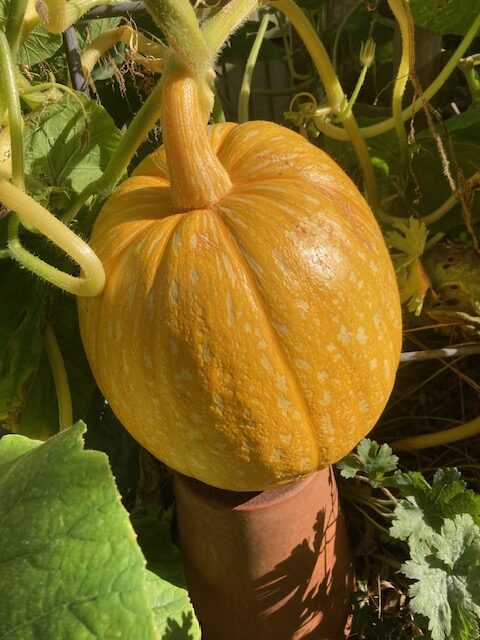It is annoying when one of your great greenhouse successes of the year is not one you planted… or even particularly wanted, but so it has proved this year. Call me a party pooper but I am not a big fan of a giant pumpkin. I love Hallowe’en and I love the pumpkin’s role in it: the great flowering of creativity that they bring out in even those who consider themselves without an artistic bone in their body – there is something about a pumpkin that relaxes people to have a go. But I don’t want to grow one, perhaps I just don’t have a strong enough competitive instinct. I would far, far rather grow smaller, odder types that have particularly dense and sweet flesh, that roast and caramelise well in the oven, than a pumpkin bred to fatten up big and fast for Hallowe’en, the broiler chickens of the vegetable bed. I want to eat my pumpkins, not submit them for judging.
My husband feels differently, and was determined to grow a monster pumpkin this year. I sense this is a male/female thing – though perhaps we won’t dwell on that too long. To be fair to him, he does just really enjoy Hallowe’en and the creative fun of carving a big pumpkin, so we’ll let him off.

He sowed seeds of ‘Atlantic Giant’ back in spring – it really does matter which variety you start with and isn’t just a case of watering and feeding any old pumpkin a lot. ‘Atlantic Giant’ is one of the best for competitive growing, and was developed by a Canadian farmer in the 1800s specifically to grow as large a pumpkin as possible. Others to try include ‘Big Max’ and ‘Prizewinner’.
Sowing time is tricky. You want them early enough for a good long growth season, but not so early that they will grow leggy while waiting to be planted out – pumpkins are tender and will be killed by a frost, so planting out can only happen once the weather has started to warm. March could be about right, giving six weeks before planting out time, but this depends on your local conditions. Start them in a heated propagator and then mollycoddle them, giving them warmth and light, until it is time to plant them out. This should be in a spot that you have enriched with plenty of manure and where there is space all around them for them to spread out. My husband planted his direct into our compost heap, reckoning that it would contain plenty of nutrients and goodness to produce a whopper, and he was right. It’s also a good idea to cover them in a cloche or horticultural fleece at this point as spring weather is notoriously fickle and temperatures can still plunge.
Those growing for competition would then begin a regime of watering and feeding aimed at maximising growth. We fed and watered, but didn’t take it all that seriously. Competition growers will also watch for fruit formation and choose their prize specimen as soon as the fruit has set. All other fruits will then be removed from the plant so that it can concentrate all of its energies on the one huge fruit. The trick then is just to keep it growing well, supporting it if it needs it, and placing something like a tile or pot beneath it so that the part that touches the soil doesn’t get wet and rot away. Once it is ripe, watch the forecast, and bring it in before any frosts.
Ours is a baby compared to those that are entered into competitions, which can weigh between 200 and 1,500 pounds, but it is bigger than all of the pumpkins in the fruit and veg shop, and it will look wonderful on our path on the 31st October.


